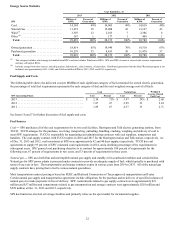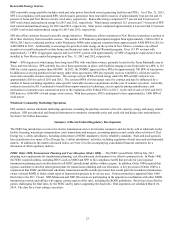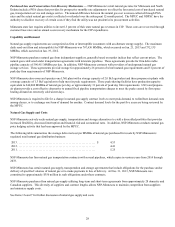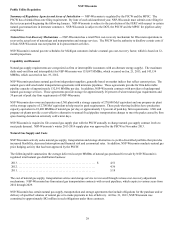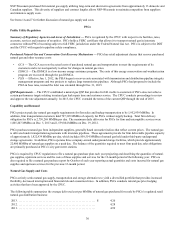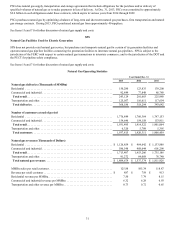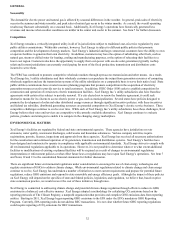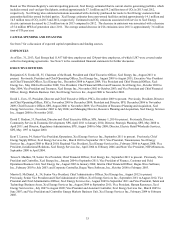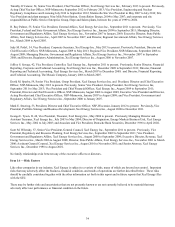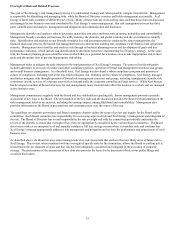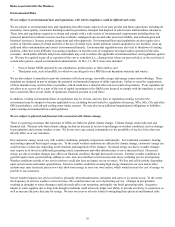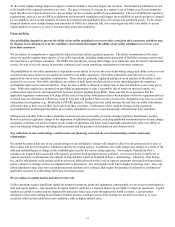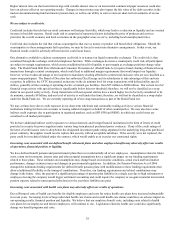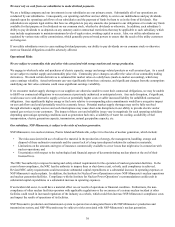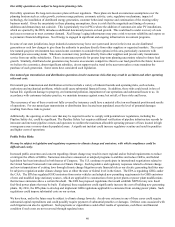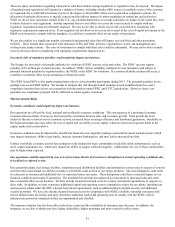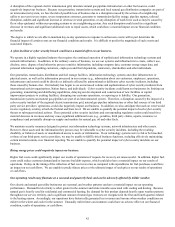Xcel Energy 2013 Annual Report Download - page 50
Download and view the complete annual report
Please find page 50 of the 2013 Xcel Energy annual report below. You can navigate through the pages in the report by either clicking on the pages listed below, or by using the keyword search tool below to find specific information within the annual report.32
GENERAL
Seasonality
The demand for electric power and natural gas is affected by seasonal differences in the weather. In general, peak sales of electricity
occur in the summer and winter months, and peak sales of natural gas occur in the winter months. As a result, the overall operating
results may fluctuate substantially on a seasonal basis. Additionally, Xcel Energy’s operations have historically generated less
revenues and income when weather conditions are milder in the winter and cooler in the summer. See Item 7 for further discussion.
Competition
Xcel Energy remains a vertically integrated utility in all of its jurisdictions subject to traditional cost-of-service regulation by state
public utilities commissions. Within this construct, however, Xcel Energy is subject to different public policies that promote
competition and the development of energy markets. Xcel Energy’s industrial and large commercial customers have the ability to own
or operate facilities to generate their own electricity. In addition, customers may have the option of substituting other fuels, such as
natural gas, steam or chilled water for heating, cooling and manufacturing purposes, or the option of relocating their facilities to a
lower cost region. Customers also have the opportunity to supply their own power with on-site solar generation (typically rooftop
solar) and in most jurisdictions can currently avoid paying for most of the fixed production, transmission and distribution costs
incurred to serve them.
The FERC has continued to promote competitive wholesale markets through open access transmission and other means. As a result,
Xcel Energy Inc.’s utility subsidiaries and their wholesale customers can purchase the output from generation resources of competing
wholesale suppliers and use the transmission systems of the utility subsidiaries on a comparable basis to serve their native load. State
public utilities commissions have created resource planning programs that promote competition in the acquisition of electricity
generation resources used to provide service to retail customers. In addition, FERC Order 1000 seeks to establish competition for
construction and operation of certain new electric transmission facilities. Xcel Energy Inc.’s utility subsidiaries also have franchise
agreements with certain cities subject to periodic renewal. If a city elected not to renew the franchise agreement, it could seek
alternative means for its citizens to access electric power or gas, such as municipalization. Several states have policies designed to
promote the development of solar and other distributed energy resources through significant incentive policies; with these incentives
and federal tax subsidies, distributed generating resources are potential competitors to Xcel Energy’s electric service business. These
competitive challenges continue to evolve over time. While each of Xcel Energy Inc.’s utility subsidiaries faces these challenges, Xcel
Energy believes their rates and services are competitive with currently available alternatives. Xcel Energy continues to evaluate
policies, products and strategies to enable it to compete in the changing energy marketplace.
ENVIRONMENTAL MATTERS
Xcel Energy’s facilities are regulated by federal and state environmental agencies. These agencies have jurisdiction over air
emissions, water quality, wastewater discharges, solid wastes and hazardous substances. Various company activities require
registrations, permits, licenses, inspections and approvals from these agencies. Xcel Energy has received all necessary authorizations
for the construction and continued operation of its generation, transmission and distribution systems. Xcel Energy’s facilities have
been designed and constructed to operate in compliance with applicable environmental standards. Xcel Energy strives to comply with
all environmental regulations applicable to its operations. However, it is not possible to determine when or to what extent additional
facilities or modifications of existing or planned facilities will be required as a result of changes to environmental regulations,
interpretations or enforcement policies or what effect future laws or regulations may have upon Xcel Energy’s operations. See Item 7
and Notes 12 and 13 to the consolidated financial statements for further discussion.
There are significant future environmental regulations under consideration to encourage the use of clean energy technologies and
regulate emissions of GHGs to address climate change. While environmental regulations related to climate change and clean energy
continue to evolve, Xcel Energy has undertaken a number of initiatives to meet current requirements and prepare for potential future
regulations, reduce GHG emissions and respond to state renewable and energy efficiency goals. Although the impact of these policies
on Xcel Energy will depend on the specifics of state and federal policies, legislation, and regulation, we believe that, based on prior
state commission practice, we would recover the cost of these initiatives through rates.
Xcel Energy is committed to addressing climate change and potential climate change regulation through efforts to reduce its GHG
emissions in a balanced, cost-effective manner. Xcel Energy adopted a methodology for calculating CO2 emissions based on the
reporting protocols of The Climate Registry, a nonprofit organization that provides and compiles GHG emissions data from reporting
entities. Starting in 2011, Xcel Energy began reporting GHG emissions to the EPA under the EPA’s mandatory GHG Reporting
Program. Currently, EPA reporting rules do not address REC transactions. It is not clear whether future GHG reporting regulations
could require reporting of CO2 emissions for REC transactions.


